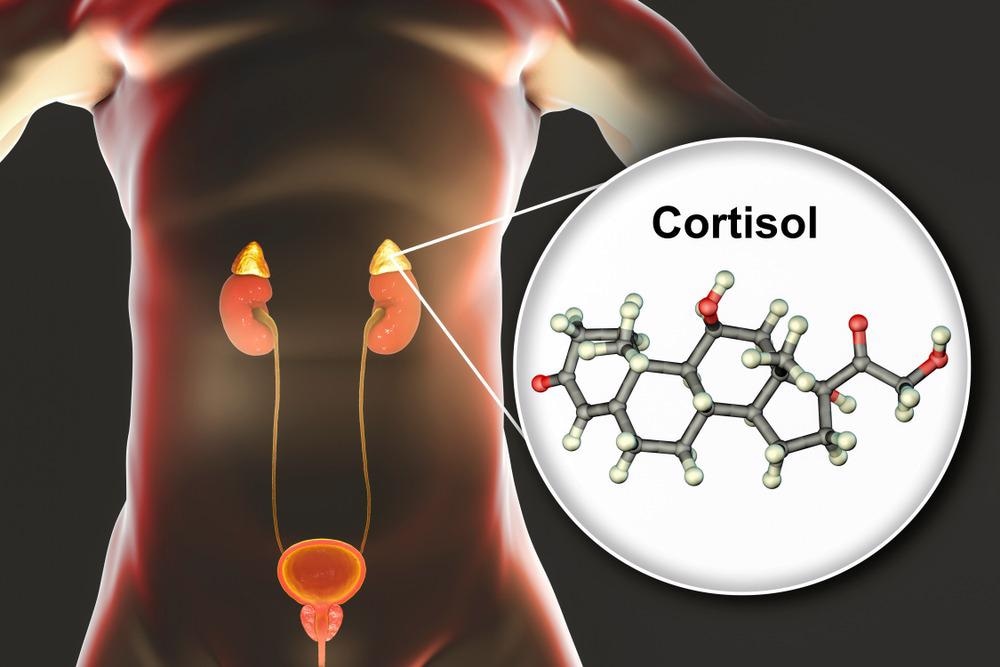A recent study published in the journal Biosensors and Bioelectronics examines the advancement of nano gold-doped molecularly imprinted electrochemical sensors for fast and sensitive detection of the steroid hormone cortisol.

Study: Nano gold-doped molecularly imprinted electrochemical sensor for rapid and ultrasensitive cortisol detection. Image Credit: Kateryna Kon/Shutterstock.com
In the sensor, target cortisol binds to imprinted spots in the polymer, changing the current of redox-active probes.
With this approach, high-density gold nanoparticles are distributed around the binding cavities of these gold-doped MIP sensors.
The in-situ gold reduction promoted polymerization, increasing the sensor's effective surface area. When subjected to redox reagents, it also aided charge transfer.
Detection responsiveness and sensitivity were reported to have improved by efficiently preventing charge transfer when cortisol occupied the cavities. In addition, this sensor demonstrated a significant adhesion for cortisol attachment, the linear detection range of 1 to 500 nM, and selectivity across additional steroid hormones that have a close resemblance.
The sensor determined normal and increased cortisol levels in spiking saliva. The simple antibody-free cortisol detection approach is extremely sensitive and selective and ideal for point-of-care tests.
Cortisol: A Steroid Hormone
The adrenal gland produces cortisol as a reaction to stress or anxiety. It modulates blood pressure, glucose, and metabolism. Deficit or excess cortisol is connected to PTSD, Cushing's illness, and CFS and elevated cortisol levels can be used to diagnose SARS-CoV-2 illness. Unbound plasma-free cortisol is measured in saliva and the salivary cortisol measurement is reliable and non-invasive.
Existing Cortisol Measurement Methods
Existing clinical cortisol measurement protocols are time-consuming and costly, requiring patients to submit urine or saliva samples for examination.
To attain sub-ng/mL limits of detection, standard approaches rely on time-consuming column chromatographic techniques. However, it is time demanding, and based on cross-reactivity with other comparable steroid hormones, it has relatively low detection selectivity.
Aside from ELISA, lateral flow tests and other immunosensors are being developed. These immunosensors detect cortisol using antibodies or aptamers, tend to have high costs, and have a short shelf life owing to environmental instability.
To substitute antibodies another option is to utilize a synthetic polymer featuring biorecognition sites for target-specific binding. Point-of-care applications are feasible when MIP is combined with electrochemical sensing technologies.
MIP-based electrochemical cortisol sensors have been demonstrated in a few publications. It was shown that the wearable MIP cortisol transistors made by UV polymerization of methyl methacrylate-based copolymer were able to detect sweat cortisol in the range of 0.01 M–5 M. However, the detection limits of these cortisol MIP sensors are unsatisfactory, and the manufacturing procedure is difficult
A Novel Gold Nanoparticle Doped MIP Cortisol Sensor
According to researchers, this gold-doped sensor can accurately detect cortisol. It has many amine groups that form hydrogen bonds with cortisol molecules during polymerization.
Poly-o-PD is also nontoxic and structurally stable, allowing a narrow and tight polymer matrix for rapid sensor response times. The AuNP doping improves electron transit between redox probes and electrodes.
Attachment of target molecules to imprinted cavities shift current responsiveness. These targets may also reduce electron transit via AuNPs, increasing detection sensitivity. Using pre-made AuNPs to polymerize MIPs has been described in a few studies.
Instead of reducing MIP's effective surface area, co-polymerization effectively enhanced it. For non-invasive steroid hormone monitoring in clinical settings, the sensor recognized normal and increased cortisol concentrations in artificial saliva correctly.
Conclusion
In this study, electrochemical cortisol sensors centered on gold nanoparticles-embedded cortisol imprinted polymers were shown by the research team. The sensor was made by electropolymerization with in situ gold reduction.
The addition of gold nanoparticles to the MIP layer improved detecting ability by increasing active surface area, enhancing electron transport across the MIP, and efficiently modulating current in response to aim cortisol capture. The Au@MIP cortisol sensor has a linear range of 1 pM to 500 nM and a detection limit of 200 fM, which was far better than previous sensors.
The sensor also detected cortisol in fake saliva samples with good recovery rates. On a discrete GCE, an efficient cortisol sensor was presently shown. For point-of-care applications, the gold-doped sensing technique may be used to screen-printed electrodes (SPE).
The gold-doped approach can also be simply adjusted to capture numerous targets for multiplexed detection. The sensor's detecting capabilities and manufacturing process demonstrate the Au@MIP's promise for low-cost, non-invasive stress detection in bodily fluids.
Reference
Yeasmin, S. et al. (2022). Nano gold-doped molecularly imprinted electrochemical sensor for rapid and ultrasensitive cortisol detection. Biosensors and Bioelectronics. Available at: https://www.sciencedirect.com/science/article/abs/pii/S0956566322001828?via%3Dihub
Disclaimer: The views expressed here are those of the author expressed in their private capacity and do not necessarily represent the views of AZoM.com Limited T/A AZoNetwork the owner and operator of this website. This disclaimer forms part of the Terms and conditions of use of this website.